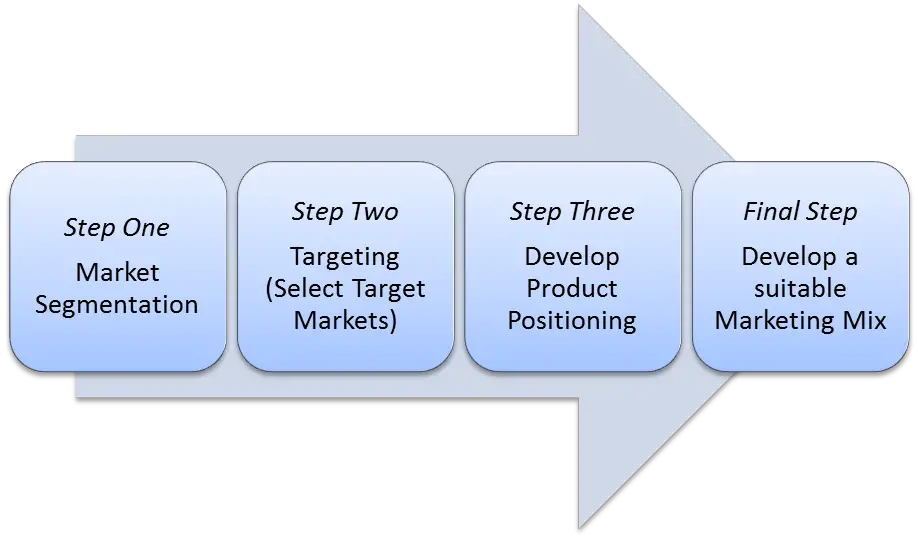Understanding the Basic STP model
In marketing, STP stands for market segmentation, targeting (or target market selection) and product positioning.
Most marketing textbooks will show the STP as three broad steps. In the below diagram, the three foundation stages of segmentation, targeting and positioning are shown, along with a final implementation stage of marketing mix development.
It is important to understand that the STP process (the first three stages) is always followed by the development and implementation of a marketing mix. And the additional of the fourth stage in the diagram simply highlights the need to effectively execute these strategic decisions.
In other words, the purpose of working through segmentation, targeting and positioning is to decide how to best compete in the market and how to effectively design the marketing mix.
Please note that STP is presented in marketing textbooks as a simple summary model to help recall its three key components. However, there are other elements to also address, which are covered in the article on the full/complete STP process.
STP helps answer key marketing questions
A good way to think about the STP process is that it is a analytical approach that helps the firm make two important marketing strategy decisions:
- ‘where to compete‘ (segmentation and target market selection) and
- ‘how to compete‘ (product positioning and marketing mix design)
You should note the use of the arrow in the above model, which indicates that STP is a sequential process. The starting point is always market segmentation, which allows the marketer to view different consumer needs and categories in the overall market.
Implementing the STP process
The Basic STP Process outlines the fundamental steps of segmentation, targeting, and positioning that guide marketers in defining and implementing an effective marketing strategy. Each step contributes to identifying where and how to compete in the marketplace.
Step 1: Start with market segmentation
Market segmentation involves dividing a broad market into smaller, more defined groups of consumers who share similar characteristics or needs. This step allows firms to focus on specific customer groups rather than trying to serve everyone.
Typically a marketer would look between three to ten market segments when dividing up one particular market. The marketer can then assess which segments best fit with the firm’s strategy and resources, as well as assessing the current and future attractiveness of each segment. (Please see ‘how target markets are selected’.)
It is important that the segments consist of consumers that have common needs, behaviors, or profiles that are relevant to the brand/products, for them to be considered suitable as market segments. And please remember that there is NO one best way to segment the market – unique approach to segmentation may create competitive advantages and generate market insights.
For example, a beverage company might segment the market by demographics (age groups such as teens, adults, and seniors), psychographics (health-conscious vs. indulgence-seeking consumers), or behavior (frequent vs. occasional drinkers).
Effective segmentation requires careful analysis and consideration of the market’s diversity to identify the most meaningful ways to group potential customers. By narrowing the market into segments, companies gain clarity on consumer preferences and can align their offerings to meet distinct needs.
Step2: Move to selecting one or more target markets
Based on this market segment analysis and evaluation, the firm will select one or more of the market segments to form part of their marketing program. Targeting involves evaluating the market segments created in the previous step and selecting one or more to focus on as the company’s target market. The goal is to determine which segments are most attractive based on factors such as:
- profitability,
- size,
- growth potential, and
- alignment with the company’s strengths and objectives.
For instance, a tech company might decide to target young professionals who value productivity and innovation when marketing a new laptop. This decision could be based on the segment’s willingness to pay for premium features and its potential for brand loyalty.
The market segment that they select is then referred to as a target market. Therefore, a target market is simply one of the many market segments available to the company that the firm has deliberately selected for the purposes of their marketing programs.
Step3: Determine a competitive positioning
After selecting a target market, the organization needs to consider how it will construct its marketing program to achieve success. There are two parts to this as shown in the diagram above.
The first is positioning, which is how the firm wants its products to be perceived (understood) by consumers in that particular market. (For more details, please refer to What is positioning?).
A key component of positioning is ensuring that the brand/product has some points of differentiation = something unique that it offers to the marketplace. A well-defined positioning strategy ensures that your product occupies a clear space in the consumer’s mind, addressing their specific needs and differentiating you from competitors.
Differentiation provides an incentive for consumers to buy – as it offers a benefit that they cannot get from a competing brand – and allows the brand to charge a price premium.
For example, Nike positions itself as a brand for athletes and aspirational achievers, with a focus on innovation, performance, and empowerment through its “Just Do It” tagline. The company uses emotional branding to connect with consumers on a deeper level, making its products synonymous with excellence and determination. Effective positioning bridges the gap between the brand’s promise and the customer’s expectations, forming the foundation for long-term loyalty.
Please note that some marketing textbooks split the STP process further into STDP by adding differentiation as its own component, which is covered in this article on the website.
Step 4: Design the marketing mix
Once the desired positioning has been determined an appropriate and supportive marketing mix then needs to be developed and implemented by the firm.
Keep in mind that positioning is executed through the full 4P’s (or 7P’ for a service firm). It is not simply part of the promotional/communication mix. If a product is positioned as “a refreshing beverage”, then it is critical that the beverage (i.e. the product itself) be refreshing.
An Example of the STP Process
Here’s a example of the STP process for a hypothetical company, FreshWave Beverages, which offers a range of natural and healthy drinks:
Step 1: Segmentation
FreshWave Beverages begins by analyzing the beverage market to identify potential customer segments. Using a mix of demographic, psychographic, and behavioral variables, they divide the market as follows:
- Health Enthusiasts:
- Demographics: Aged 25–45, middle to high income.
- Psychographics: Highly health-conscious, prefer natural and organic products.
- Behavior: Regular buyers of low-sugar, nutrient-rich beverages.
- On-the-Go Professionals:
- Demographics: Aged 20–40, urban, middle income.
- Psychographics: Time-poor but value convenience.
- Behavior: Prefer ready-to-drink products for work or commutes.
- Budget-Conscious Families:
- Demographics: Parents aged 30–50, middle to low income.
- Psychographics: Focus on affordable, family-friendly products.
- Behavior: Purchase in bulk, seek value-for-money options.
- Active Lifestyle Seekers:
- Demographics: Aged 18–35, diverse income levels.
- Psychographics: Fitness-focused, enjoy outdoor and gym activities.
- Behavior: Look for functional beverages like protein shakes and electrolyte-rich drinks.
Step 2: Targeting
After evaluating the segments, FreshWave selects Health Enthusiasts and Active Lifestyle Seekers as their target markets. They base this decision on:
- Segment Size and Growth: Both segments are growing due to rising health consciousness.
- Profitability: Health Enthusiasts are less price-sensitive and willing to pay a premium for quality, while Active Lifestyle Seekers represent recurring high-value customers.
- Alignment with Strengths: FreshWave’s brand focuses on natural, functional beverages, aligning perfectly with these segments’ needs.
Step 3: Positioning
FreshWave develops a clear positioning strategy for each target market:
- For Health Enthusiasts:
- Positioning: “FreshWave Beverages – A Natural Boost for Your Well-Being.”
- Message: Emphasizes the use of organic ingredients, low-calorie options, and no artificial additives.
- Example Product: A cold-pressed juice line with superfoods like kale, turmeric, and ginger.
- Supporting Marketing Mix:
- Product: Organic certification, recyclable packaging.
- Price: Premium pricing to reflect quality.
- Place: Distributed in health food stores, gyms, and online.
- Promotion: Social media campaigns showcasing health benefits, endorsements by nutritionists.
- For Active Lifestyle Seekers:
- Positioning: “FreshWave Beverages – Fuel Your Performance Naturally.”
- Message: Highlights functional benefits like hydration, recovery, and energy.
- Example Product: An electrolyte drink with natural coconut water and added BCAAs for athletes.
- Supporting Marketing Mix:
- Product: Functional features like hydration and recovery benefits.
- Price: Competitive pricing for high repeat purchases.
- Place: Available in gyms, sports stores, and vending machines near fitness centers.
- Promotion: Partnerships with fitness influencers and sponsorship of local sports events.
FAQs for the Basic STP Process
What does STP stand for in marketing?
- STP stands for Segmentation, Targeting, and Positioning. It is a framework used by marketers to identify distinct customer groups, select the most viable target market(s), and position their product to appeal to the chosen audience effectively.
What are the three broad steps of the Basic STP Process?
The Basic STP Process consists of:
- Segmentation: Identifying distinct groups within the market.
- Targeting: Evaluating and selecting the most viable segments to focus on.
- Positioning: Crafting a strategy to differentiate and align the product with the chosen target market.
Why is segmentation always the starting point?
- Segmentation is the foundation of the STP process because it helps marketers understand the diversity of customer needs in a market. Without segmentation, targeting and positioning would lack direction and specificity.
What is the difference between the Basic and Full STP Process?
- The Basic STP Process covers three broad steps: segmentation, targeting, and positioning. The Full STP Process expands these steps into nine detailed stages, such as defining the market, constructing segment profiles, and developing the marketing mix.
Why is the STP process important for businesses?
- The STP process helps businesses focus their resources on the most promising market segments, create tailored marketing strategies, and differentiate themselves from competitors. This targeted approach improves efficiency, relevance, and customer satisfaction.
What is the goal of positioning?
- Positioning aims to define how a product or brand is perceived in the customer’s mind, particularly in relation to competitors. It establishes a unique value proposition and differentiates the product based on attributes like quality, price, or benefits.
What is an example of positioning?
- In the worked example, FreshWave Beverages positions its products for Health Enthusiasts as “A Natural Boost for Your Well-Being” by emphasizing organic ingredients and sustainability. For Active Lifestyle Seekers, the positioning is “Fuel Your Performance Naturally,” focusing on functional benefits like hydration and energy.
Can a company target more than one market segment?
- Yes, companies can target multiple segments as long as they have distinct marketing strategies and resources to address the unique needs of each segment effectively. For example, FreshWave Beverages targets both Health Enthusiasts and Active Lifestyle Seekers with tailored strategies.
How does targeting improve marketing effectiveness?
- Targeting ensures marketing efforts are directed at the most receptive audience. By understanding and addressing specific needs, companies can create more engaging campaigns, increase conversions, and maximize return on investment.
What is the role of the marketing mix in the STP process?
- After segmentation, targeting, and positioning, the marketing mix (product, price, place, and promotion) must align with the positioning strategy to deliver the promised value. For example, FreshWave used premium pricing and health-store distribution for Health Enthusiasts while offering competitive pricing and gym-based availability for Active Lifestyle Seekers.
Further readings
For a greater understanding of the STP model, you should review the Full STP Process.
Academic readings
Market Segmentation, Targeting, and Positioning


